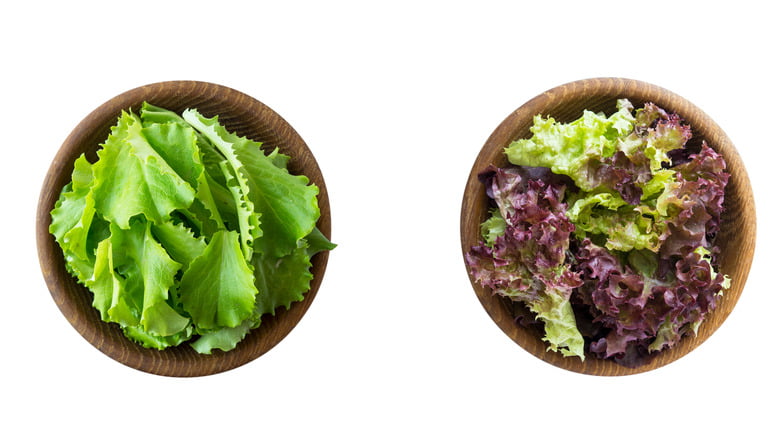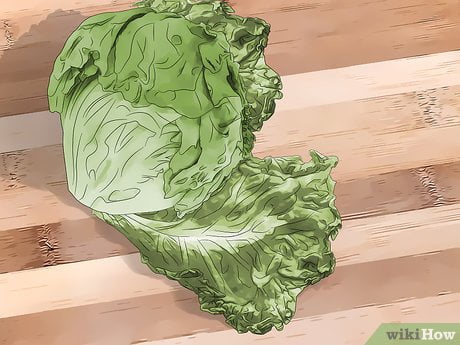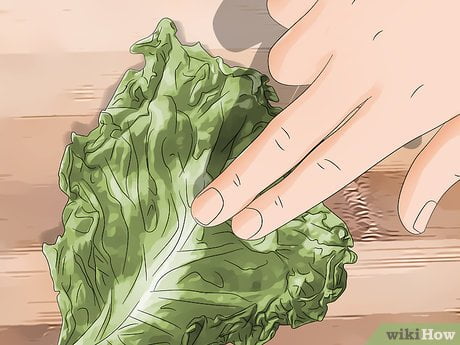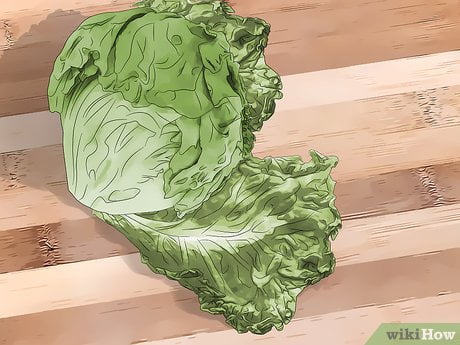So you’re standing in your kitchen, about to whip up a fresh salad for lunch. As you reach for a head of lettuce from your fridge, a sudden thought crosses your mind: what does bad lettuce smell like? We’ve all been there, hesitating as we wonder if the lettuce is still good or if it has gone bad. In this article, we are going to explore the distinctive smell of spoiled lettuce, helping you to identify when it’s time to bid farewell to that wilted, unpleasant aroma.

Signs of Spoiled Lettuce
When it comes to lettuce, freshness is key. However, sometimes it’s not always easy to tell whether your lettuce has gone bad just by looking at it. That’s why it’s important to familiarize yourself with the signs of spoiled lettuce. By knowing what to look out for, you can avoid consuming lettuce that might be past its prime and potentially harmful to your health. Here are some common signs of spoiled lettuce:
Discoloration
One of the most obvious signs that your lettuce has spoiled is discoloration. This can manifest in various ways, such as darkening or browning of the leaves. If you notice any visible changes in the color of your lettuce, it’s a clear indication that it’s no longer fresh. In addition to darkening or browning, you may also notice yellow or wilting appearance, or even purple spots or streaks on the leaves. These are all signs of lettuce that is past its prime and should not be consumed.
Sliminess
Another telltale sign of spoiled lettuce is sliminess. When lettuce starts to spoil, it becomes wet and develops an unpleasant slimy texture. This excessive moisture can be a breeding ground for bacteria and mold, making the lettuce unsafe to eat. If you come across slimy lettuce while preparing a salad or sandwich, it’s best to discard it immediately to avoid any potential health risks.
Unpleasant Odor
Spoiled lettuce often emits an unpleasant odor, which can vary depending on the extent of the spoilage. Rancid or decaying odor is a common smell associated with spoiled lettuce. If your lettuce has a strong ammonia-like smell, it’s a sure sign that it has gone bad. Additionally, a sour or fermented aroma may indicate spoilage. Trust your nose when it comes to the smell of your lettuce, as it can be a reliable indicator of whether it’s still fresh or not.
Mold Growth
The presence of mold is a definite sign that your lettuce is spoiled and should not be consumed. Mold can appear as visible spots on the lettuce leaves, ranging from fuzzy to powdery texture. These spots can be black, green, or white in color. In addition to the visual cues, mold growth on lettuce often produces a musty or earthy smell. If you notice any signs of mold on your lettuce, it’s essential to discard it immediately to avoid any potential health risks associated with consuming moldy food.
Causes of Lettuce Spoilage
Understanding the causes of lettuce spoilage can help you better prevent it from happening in the first place. Lettuce can spoil due to various factors, including bacterial and fungal growth, as well as environmental factors.
Bacterial Growth
Bacterial growth is a common cause of lettuce spoilage. When lettuce is contaminated with harmful bacteria, they can multiply rapidly under favorable conditions, leading to spoilage and potential foodborne illnesses. Some common bacteria that can cause lettuce spoilage include Salmonella and E. coli. These bacteria can contaminate lettuce through improper handling, unclean water, or unsanitary conditions.
Fungal Growth
Fungal growth is another factor that can contribute to lettuce spoilage. Fungi, such as molds and yeasts, thrive in humid environments and can quickly colonize lettuce, causing it to spoil. Mold growth on lettuce is not only visually unappealing but can also produce dangerous toxins, which can be harmful if ingested. It’s important to store lettuce in a cool and dry place to minimize the risk of fungal growth.
Environmental Factors
Environmental factors, such as temperature, humidity, and air quality, can also play a significant role in lettuce spoilage. Lettuce is highly perishable and is sensitive to changes in its surroundings. Exposure to high temperatures can accelerate deterioration and bacterial growth, leading to spoilage. Similarly, excessive humidity can create a breeding ground for fungi and accelerate lettuce decay. Poor air quality, such as exposure to smoke or strong odors, can also contribute to lettuce spoilage.

Identifying the Smell of Spoiled Lettuce
When determining whether your lettuce has gone bad, the smell can be a helpful indicator. A good rule of thumb is that fresh lettuce should not have a strong or unpleasant odor. However, when lettuce spoils, it can emit distinct smells that may signify spoilage. Here are some common smells associated with spoiled lettuce:
Rancid or Decaying Odor
Spoiled lettuce often has a rancid or decaying odor. This smell is unpleasant and indicates that the lettuce has surpassed its freshness and is no longer safe to eat. If your lettuce smells off or has a putrid scent, it’s best to discard it rather than risk consuming spoiled food.
Ammonia-like Smell
If you detect an ammonia-like smell coming from your lettuce, it’s a clear indication that it has spoiled. This odor is often strong and overpowering, and it signals that bacterial or fungal growth has occurred. Consuming lettuce with an ammonia-like smell can lead to food poisoning, so it’s crucial to discard it immediately.
Sour or Fermented Aroma
Spoiled lettuce can also have a sour or fermented aroma. This smell is indicative of the breakdown of organic matter, which occurs during spoilage. If your lettuce smells sour or fermented, it’s best to err on the side of caution and avoid consuming it.
Steps to Determine Spoilage
Now that you are familiar with the signs and smells of spoiled lettuce, let’s explore some steps you can take to determine whether your lettuce has actually gone bad.
Inspect for Visible Signs
The first step in determining lettuce spoilage is to visually inspect the lettuce. Look for any discoloration, such as darkening or browning of the leaves, yellowing or wilting appearance, or the presence of mold spots. Additionally, check for sliminess or excessive moisture on the leaves. Any visible signs of spoilage are a clear indication that the lettuce is no longer fresh.
Perform the Sniff Test
After visually inspecting the lettuce, perform the sniff test. Take a whiff of the lettuce and trust your sense of smell. If you detect any unpleasant or off-putting odors, such as a rancid, ammonia-like, sour, or putrid smell, it’s a sign that the lettuce has spoiled. Remember, fresh lettuce should not have a strong odor.
Compare with Fresh Lettuce
If you’re uncertain about whether your lettuce has spoiled or not, it can be helpful to compare it with fresh lettuce. Take a piece of fresh lettuce and compare its appearance, texture, and smell with the lettuce in question. If there are noticeable differences, such as discoloration, sliminess, or unpleasant odors in the suspect lettuce, it’s likely that it has gone bad.
Consider Personal Sensitivity
Lastly, it’s essential to consider your own sensitivity to spoiled food. Some individuals may have a higher tolerance for consuming slightly spoiled lettuce without experiencing adverse effects, while others may be more susceptible to foodborne illnesses. If you have a compromised immune system or are particularly sensitive to food spoilage, it’s best to err on the side of caution and avoid consuming any questionable lettuce.

Discoloration
Discoloration is a common visual sign of lettuce spoilage. Pay attention to the following types of discoloration that may indicate spoiled lettuce:
Darkening or Browning of Leaves
When lettuce starts to spoil, its leaves may darken or brown. This discoloration is a result of enzymatic reactions that occur as the lettuce deteriorates. Once the leaves turn dark or brown, it’s a clear indication that the lettuce is past its prime and should not be consumed.
Yellow or Wilting Appearance
In addition to darkening or browning, lettuce that is spoiled may also exhibit a yellow or wilting appearance. The vibrant green color of fresh lettuce will fade, and the leaves may become limp and wilted. Keep an eye out for these visual cues, as they are a clear indication that the lettuce has lost its freshness.
Purple Spots or Streaks
Sometimes, spoiled lettuce can develop purple spots or streaks on the leaves. This discoloration can occur as a result of fungal or bacterial growth. While not all purple spots on lettuce indicate spoilage, it’s best to exercise caution and avoid consuming lettuce with abnormal discoloration.
Sliminess
Sliminess is a tactile sign that your lettuce has gone bad. When lettuce spoils, it often becomes excessively moist, leading to a slimy texture. Pay attention to the following sliminess-related signs of lettuce spoilage:
Excessive Moisture
Spoiled lettuce will feel excessively moist to the touch. This excessive moisture can be a breeding ground for bacteria and mold, increasing the risk of foodborne illnesses. If you notice that your lettuce feels excessively wet or slimy, it’s best to discard it immediately.
Texture Changes
In addition to excessive moisture, spoiled lettuce may undergo texture changes. The leaves can become soft and mushy, losing their crispness and crunch. These textural changes are a clear indication that the lettuce is no longer fresh and should not be consumed.
Stickiness
Spoiled lettuce can also feel sticky to the touch, which is another indicator of sliminess. If you notice a sticky residue on the leaves or your fingers after handling the lettuce, it’s a sign that decomposition has occurred. It’s advisable to dispose of the lettuce to prevent any potential health risks.

Unpleasant Odor
The smell of spoiled lettuce can be quite distinctive. Pay attention to the following unpleasant odors that may indicate spoiled lettuce:
Rancid or Off-putting Smell
Spoiled lettuce often emits a rancid or off-putting smell. It can be described as a foul odor or a scent similar to decaying matter. If your lettuce has a strong and unpleasant smell, it’s a clear indication that it has gone bad and should be discarded.
Strong Ammonia-like Odor
Another type of odor associated with spoiled lettuce is a strong ammonia-like smell. This smell is often overpowering and can indicate the presence of harmful bacteria or excessive breakdown of proteins. Consuming lettuce with an ammonia-like odor can lead to food poisoning, so it’s best to avoid it altogether.
Vinegary or Sour Aroma
Spoiled lettuce can also emit a vinegary or sour aroma. This smell is a result of bacteria breaking down organic matter and producing volatile compounds. If your lettuce smells vinegary or sour, it’s a sign that spoilage has occurred, and it’s best to discard it to prevent any potential health risks.
Putrid or Rotting Scent
Lastly, spoiled lettuce can have a putrid or rotting scent. This smell is often strong and can be described as foul or nauseating. If your lettuce emits a putrid or rotting scent, it’s a clear indication that it has surpassed its freshness and should not be consumed.
Mold Growth
Mold growth is a common issue with lettuce that has gone bad. Pay attention to the following signs of mold growth that may indicate spoiled lettuce:
Visible Mold Spots
One of the most apparent signs of spoiled lettuce is the presence of visible mold spots. Mold can appear as fuzzy, green, black, or white spots on the lettuce leaves. If you notice any mold growth on your lettuce, it’s crucial to discard it immediately. Consuming moldy lettuce can lead to adverse health effects, particularly for individuals with allergies or weakened immune systems.
Fuzzy or Powdery Texture
In addition to visible mold spots, mold can affect the texture of lettuce. Spoiled lettuce may feel fuzzy or powdery to the touch, indicating the colonization of the fungus on the leaves. These textural changes are an unmistakable sign of lettuce spoilage.
Musty or Earthy Smell
Mold growth on lettuce often produces a musty or earthy smell. If you detect this type of odor coming from your lettuce, it’s a clear indication that mold has taken hold. Moldy lettuce should never be consumed, as it can pose serious health risks.

Bacterial Growth
Bacteria can also contribute to lettuce spoilage. Understanding the process of bacterial growth can help you better prevent lettuce from spoiling. Here’s what you need to know about bacterial growth and its impact on lettuce:
Bacteria-on-Lettuce
Lettuce can become contaminated with bacteria in various ways. Improper handling, such as touching lettuce with dirty hands, can introduce harmful bacteria onto the leaves. Contaminated water used for irrigation or washing can also be a source of bacterial contamination. Additionally, unsanitary conditions during growing, harvesting, or packaging can lead to bacterial contamination of lettuce.
Process of Bacterial Spoilage
Once bacteria are introduced onto lettuce, favorable conditions can lead to rapid bacterial growth. Bacteria feed on the nutrients present in lettuce and reproduce, causing the lettuce to spoil. Common bacteria that can lead to lettuce spoilage include Salmonella and E. coli, both of which can cause foodborne illnesses if consumed.
To minimize the risk of bacterial spoilage, it’s essential to practice good hygiene and proper food handling. Thoroughly wash your hands before handling lettuce, and ensure that all utensils, surfaces, and containers are clean. Additionally, it’s advisable to purchase lettuce from reputable sources and store it properly to prevent bacterial growth.
Environmental Factors
Environmental factors play a crucial role in lettuce spoilage. Understanding these factors can help you create optimal conditions to prevent lettuce from going bad. Here are some environmental factors to consider:
Temperature
Lettuce is highly sensitive to temperature changes, particularly heat. Exposure to high temperatures accelerates the deterioration process and can lead to bacterial and fungal growth. To prolong the freshness of lettuce, it’s best to store it in a cool environment, such as in the refrigerator. The ideal temperature for lettuce storage is around 32 to 36 degrees Fahrenheit (0 to 2 degrees Celsius).
Humidity
Humidity levels also affect lettuce’s shelf life. Excessive humidity can create a breeding ground for fungi and accelerate lettuce decay. To minimize humidity exposure, store lettuce in a dry environment. Consider using airtight containers or plastic bags with holes to maintain the optimal humidity level.
Air Quality
Poor air quality can also contribute to lettuce spoilage. Exposure to smoke, strong odors, or ethylene gas can hasten lettuce deterioration. Ethylene gas is a natural plant hormone that accelerates the ripening process and can cause lettuce to spoil faster. Avoid storing lettuce near ethylene-producing fruits, such as apples or bananas, to prevent premature spoilage.
By being aware of these environmental factors and taking appropriate measures, you can extend the shelf life of your lettuce and minimize the risk of spoilage.
In conclusion, being able to identify the signs of spoiled lettuce is essential for maintaining food safety. Discoloration, sliminess, unpleasant odor, and mold growth are all indicators that your lettuce has gone bad. Understanding the causes of lettuce spoilage, such as bacterial and fungal growth, as well as environmental factors, can help you prevent spoilage from occurring. Additionally, the smell of spoiled lettuce can provide valuable insights into its freshness. By following the steps to determine spoilage, such as inspecting for visible signs, performing the sniff test, comparing with fresh lettuce, and considering personal sensitivity, you can make informed decisions about whether to consume or discard lettuce. Remember to prioritize food safety and always err on the side of caution to protect your health.



